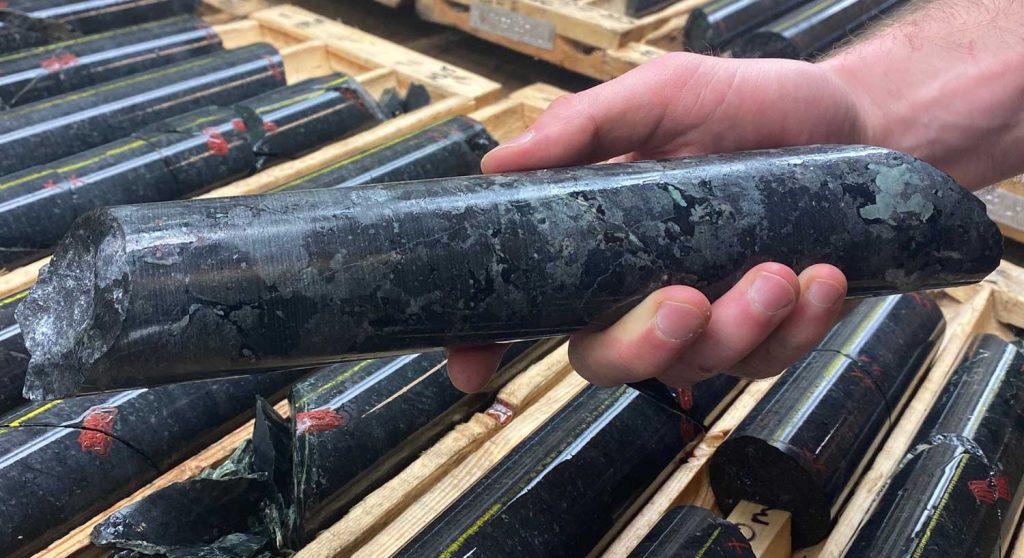Canada Nickel reports new nickel discovery at Reid, Ontario

Canada Nickel Company Inc. [CNC-TSXV; CNIKF-OTCQB] has made a new nickel discovery at its Reid property, northeast Ontario, where two drill holes have been completed as part of its regional exploration program. Drilling has commenced at Reid, as well as the company’s Deloro and Reaume properties, and assays from earlier drilling at Nesbitt have been received.
Mark Selby, Chair and CEO, said, “Our regional exploration program intended to highlight the potential for multiple Crawford-sized discoveries has taken several big steps forward. At Reid, a target with a larger footprint than Crawford, our second hole intersected dunite across the entire core length and contained an 84-metre interval which was visibly mineralized to similar extent as Crawford Higher Grade Core. We extended the discovery at Deloro and intersected target mineralization at Reaume – all of which confirm the success of our geophysical targeting model. We are further encouraged by these results as they represent targets we can easily access and are not our highest potential targets. We expect to have access to the full target base through this year and we are looking forward to exploring their potential.”
The Reid property is located just 16 km southwest of the 100%-owned Crawford property 42 km north of Timmins, northeast Ontario. The property contains a series of folded ultramafic bodies that measure 3.3 km north-south by 2.1 km east-west based on the total magnetic intensity (TMI). The company has completed two holes both of which collared in dunite.
Additional drilling at Reid postponed until the spring thaw. Drilling will resume in late spring.
The Deloro property is located 8 km south of Timmins and contains an ultramafic target measuring 1.4 km long by 300-500 metres wide. The company has now completed seven holes at Deloro, all on the northern half of the intrusion. The first five holes collared in mineralized dunite and stayed primarily in dunite/peridotite. The last two holes (DEL22-06 and DEL22-07) were collared closer to the west contact to test for the presence of PGM in pyroxenite and for gold which was intersected in a historical hole. Mineralogy completed on samples from these holes confirmed that they contain the same heazlewoodite-pentlandite-awaruite minerals as Crawford.
DEL22-01, collared in the centre of the ultramafic target and drilled toward the west contact, intersected mineralized dunite (including some narrow dykes) starting at 1.8 metres downhole. Holes DEL22-03, DEL22-04 and DEL 22-05 all intersected thick dunite sequences with some peridotite. DEL22-06 and DEL22-07 intersected dunite followed by pyroxenite and then gabbro. Drilling will resume later this spring.
The Nesbitt nickel property is located just 9 km north-northwest of Canada Nickel’s Crawford nickel sulphide property on patented mining claims acquired from Noble Mineral Exploration. The property includes two ultramafic sills that strike east-west, the larger sill being 3.7 km long. Original estimates suggested a width of 100 to 300 metres. Preliminary drill results were previously announced for NES21-01 and NES21-02 and NES21-03.
NES21-06 was drilled in the northern sill and intersected lower-grade mineralization encountering 483.8 metres of 0.17% nickel within a peridotite sill containing minor dunite. NES21-01 returned 131.5 metres (84.5 metres TW) of 0.23% nickel and 0.01% cobalt. Including 34.5 metres (22.2 metres TW) of 0.25% nickel and 0.011% cobalt. Nes21-02 returned 296.5 metres (190.6 metres TW) of 0.23% nickel and 0.01% cobalt. The other holes returned similar mineralization, including minor credits in palladium, platinum and chromium. Refer to original company press release for complete assays.
The Reaume property 19 km northwest of Crawford, contains an ultramafic target of approximately 3 km (east-west) by 1.8 km (north-south) as defined by its magnetic footprint and historical drilling.
Canada Nickel has drilled three holes at Reaume into the ultramafic intrusion, all three of which intersected dunite/peridotite. REU22-01 intersected 410.6 metres of serpentinized peridotite, dunite and altered dunite below 9.4 metres of overburden. REU22-02 intersected 242.5 metres of serpentinized peridotite below 4.5 metres of overburden. REU22-03 intersected a series of ultramafic rocks including peridotite, pyroxenite and gabbro through what is considered the upper portion of the intrusion, typically where the PGM zone is situated. Drilling will resume later this year.
